ERS Charts of Note
Subscribe to get highlights from our current and past research, Monday through Friday, or see our privacy policy.
Get the latest charts via email, or on our mobile app for  and
and 
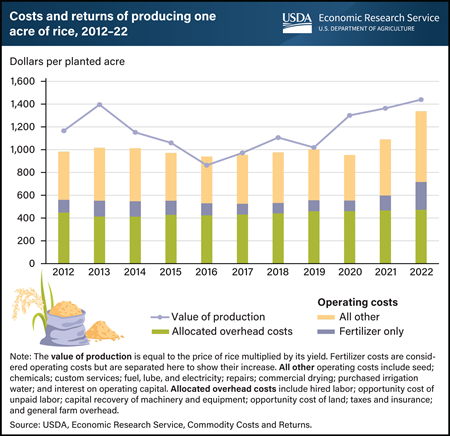
Thursday, January 4, 2024
According to data from USDA’s Economic Research Service (ERS), recent returns from rice farming are positive, on average. From 2012 to 2022, U.S. rice farmers received a positive net return (equal to the value of production minus costs) in all years except 2016, when rice fell to its lowest price of that decade. The total gross value of producing one acre of rice increased 23 percent over that time, ranging from a low of $863.46 in 2016 to a high of $1,439.19. This was, in part, because of strengthening rice prices. Notably, rice prices surged in recent years before reaching an all-time high in 2022. Over the 2012 to 2022 period, the total cost of producing one acre of rice increased by 36 percent. Most of the increase in cost stemmed from an increase in operating costs of 62 percent, while allocated overhead costs increased 6 percent. Surging fertilizer costs, which increased by $150.75 per acre from 2020 to 2022, largely drove the increase. By contrast, allocated overhead costs—a category that includes labor costs and the opportunity cost of land—increased by $12.09 since 2020. This chart is based on data collected from the ERS Commodity Costs and Returns data product.
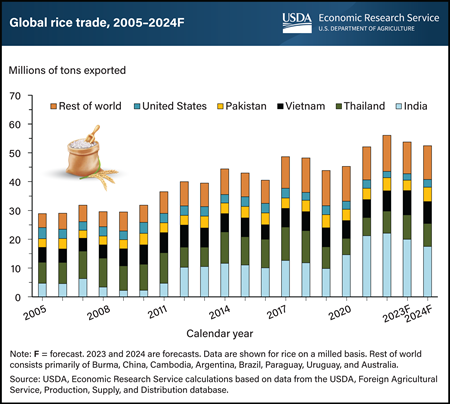
Wednesday, October 18, 2023
Global rice trade is projected to decline in 2023 and 2024 after India, the world’s largest rice exporter, implemented additional export restrictions on rice in July and August 2023. India accounted for more than 40 percent of global exports in 2022, supplying more rice than each of the next four largest suppliers—Thailand, Vietnam, Pakistan, and the United States. In summer 2023, India placed a ban on export sales of regular-milled white rice while imposing tariffs and additional restrictions on other types of exported rice. Global prices for rice then rose by 12 to 14 percent by the end of July. Prices continued to surge in August, reaching their highest since 2008, dropping slightly by mid-September as panic buying slowed. The impact is felt by many of the world’s food-insecure countries, especially in Sub-Saharan Africa, India’s largest export market. This region is expected to import less rice in 2023 and 2024 even as Thailand, Vietnam, and Pakistan pick up additional sales, despite tight supplies in Thailand and Vietnam. This chart is drawn from the October 2023 Rice Outlook, published by USDA, Economic Research Service. Also see the August 2023 and September 2023 Rice Outlook.
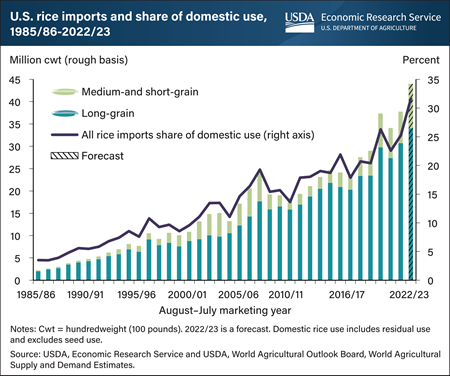
Wednesday, September 21, 2022
U.S. rice imports for the 2022/23 marketing year (August–July) are projected to rise 16 percent from a year earlier and to reach the highest volume on record at 44 million hundredweight. Imported rice is also projected to account for almost 32 percent of domestic use of rice in 2022/23, the highest share on record. Imports of long-grain and the combined classes of short- and medium-grain rice are projected at all-time highs. For long-grain rice, the dominant class of rice grown and consumed in the United States, growing consumer preference for Asian aromatic rice, such as jasmine rice from Thailand and basmati rice from India and Pakistan, has driven the increase in import purchases. In addition to the long-grain Asian aromatic varieties, the United States has been importing a much smaller volume of regular milled long-grain rice from South American suppliers. For the combined medium- and short-grain rice classes, a 41-percent expansion of imports is projected for 2022/23. Increasing imports are spurred by reduced production in California, where a second consecutive year of drought has reduced the size of the rice harvest and available domestic supplies. The California rice crop is forecast down 38 percent from a year earlier and is expected to be the smallest crop since 1977/78. California grows almost exclusively medium- and short-grain rice and typically accounts for around 70 percent of U.S. medium- and short-grain production. The United States regularly imports medium- and short-grain rice from Thailand, India, China, and Italy, with nearly all the rice from China going to the U.S. territory of Puerto Rico. The information in this chart is based on information in the USDA, Economic Research Service Rice Outlook, September 2022.
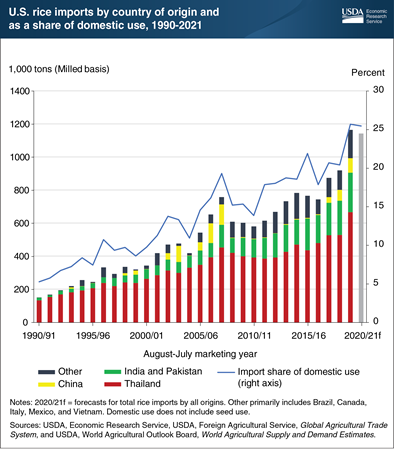
Friday, October 9, 2020
U.S. rice imports hit record highs in the second quarter of calendar year 2020, driving up total U.S. rice imports to a record high in marketing year 2019/20 and up 29 percent from the previous year. Imports now account for more than one-quarter of all rice that is used domestically. Growing consumer demand for Asian aromatic varieties of rice drive this development. Although the United States itself produces several aromatic varieties of rice, the consumer qualities are not the same as those for the Asian varieties. The bulk of the increase in U.S. rice imports in 2019/20 came from Thailand, up almost 29 percent from a year earlier. In recent years, 80-85 percent of Thailand’s shipments to the United States has been its jasmine rice, a premium aromatic variety. Combined U.S. imports from India and Pakistan increased 24 percent in 2019/20 to a record 262,000 tons, with most of this rice being basmati rice, also a premium aromatic. Imports of non-aromatic rice have increased as well. China has recently been shipping 66,000-86,000 tons of rice annually, with the U.S. territory of Puerto Rico buying almost all this amount; this market was previously supplied with U.S. rice. The Government of China has been selling its stocks of older rice at substantially discounted prices. Finally, Brazil’s shipments have increased considerably since 2017/18, shipping both regular long-grain milled rice for food use and broken kernel rice for use in processed products. Rice imports in 2020/21 are expected to continue at a strong clip, falling only slightly from the 2019/20 record high with the United States remaining the largest importer in the Western Hemisphere. This chart is drawn from Economic Research Service’s Rice Outlook, September 2020.
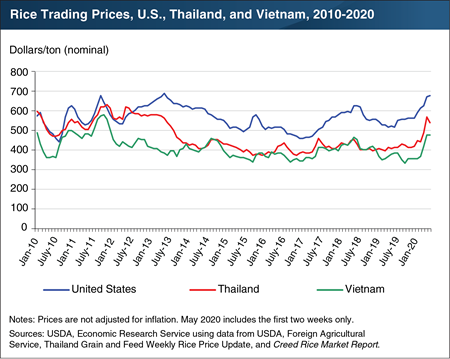
Wednesday, May 27, 2020
Global rice price movements typically have major impacts on import levels in price-sensitive markets, particularly in sub-Saharan Africa, the world’s largest rice importing region, where rice is becoming increasingly important to the diet of many lower-income households. Despite projections for near-record global rice supplies in 2019/20, trading prices for rice in mid-April rose to their highest points in more than 7 years after several major exporting countries imposed export bans and restrictions in March as a response to heightened concerns over domestic food security following the outbreak of COVID-19. The rapid increase in global prices occurred as trade restrictions first announced in March in Southeast Asia sharply reduced global exportable supplies. The reduction in the already-small number of rice suppliers immediately affected global prices, including those from the United States, a major rice exporter. U.S. prices, which were already well above competitors’ levels, increased 10 percent in mid-April from late February. Over the same time period, price quotes for Thailand’s exported rice had increased 32 percent, and Vietnam’s had increased almost 25 percent. Apart from export restrictions, temporary mandatory lockdowns in two major rice-exporting nations, India and Pakistan, hindered the movement of rice to the port for export, and further reduced exportable supplies. During the first two weeks of May, Thailand’s prices dropped slightly while the United States’ and Vietnam’s prices remained unchanged. The amount of rice traded globally is currently projected to decline more than 1 percent in 2020 from the previous year and then increase 5 percent in 2021. This chart is based on the May 2020 Rice Outlook.
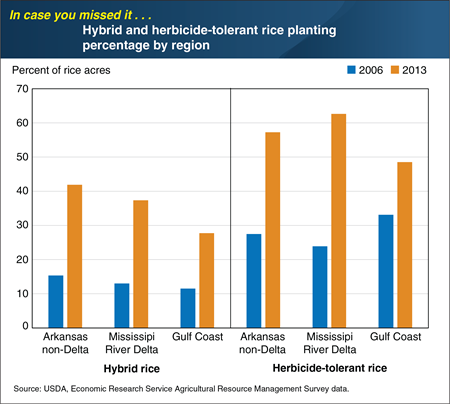
Tuesday, September 3, 2019
Data from USDA’s Agricultural Resource Management Survey of U.S. rice farms indicate that southern rice producers increased the planting of both hybrid and herbicide-tolerant seed between 2006 and 2013. Hybrid rice gained favor primarily because it is higher yielding than conventional rice. From 2006 to 2013, hybrid rice acreage increased in all major southern rice-producing regions. Herbicide-tolerant rice is bred to withstand applications of specific herbicides that kill targeted weeds, particularly “red rice” in the South. This feature allows producers to apply herbicides after both the rice and weeds have emerged, killing targeted weeds without harming the rice. Unlike other herbicide-tolerant crops, herbicide-tolerant rice varieties have been developed through traditional plant-breeding methods rather than genetic modification. From 2006 to 2013, herbicide-tolerant rice acreage increased from 27 to 57 percent of acres in the Arkansas Non-Delta, from 24 to 63 percent of acres in the Mississippi River Delta, and from 33 to 49 percent of acres in the Gulf Coast. These data appear in the ERS report, U.S. Rice Production in the New Millennium: Changes in Structure, Practices, and Costs. This Chart of Note was originally published December 10, 2018.
Record rice stocks are projected to continue, with China responsible for 68 percent of global levels
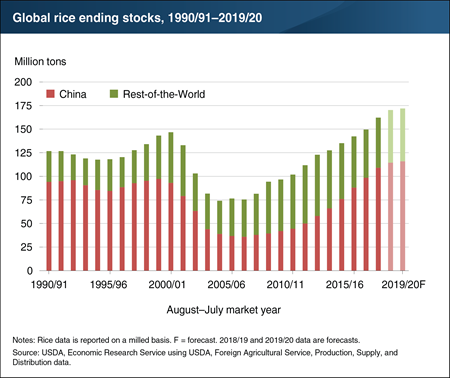
Wednesday, July 31, 2019
Global ending stocks of rice are projected to reach 171.9 million tons in the 2019/20 marketing year (August–July), the highest on record and the 13th consecutive year of expansion. The phrase “ending stocks” refers to the amount of a given commodity held in storage at the end of a marketing year rather than being consumed domestically or exported. High ending stocks put downward pressure on prices because they are carried over from year to year, inflating potential supply levels beyond what is produced in a given year. China accounts for the bulk of the increase in global stocks since the mid-2000s, with China’s 2019/20 ending stocks projected at a record 116 million tons or almost 68 percent of global ending stocks. China’s substantial stocks build-up since 2007/08 is largely due to producer-support programs that purchased rice from farmers at prices above market levels. In contrast to China’s rising stocks, rice stocks held outside of China in 2019/20 are projected at 55.9 million tons, virtually unchanged from a year earlier and nearly equal to the 2007/08-2018/19 average. This chart is drawn from data discussed in the ERS Rice Outlook report and appears in the ERS Rice Chart Gallery, updated in July 2019.
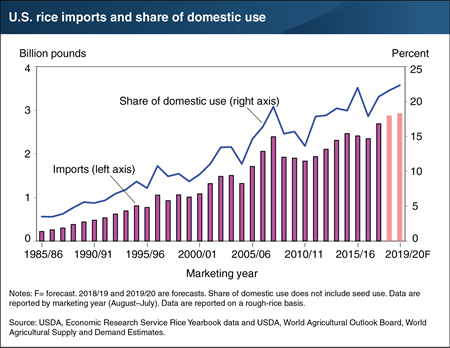
Monday, July 8, 2019
U.S. rice imports are projected to reach record levels in the 2019/20 marketing year (August–July). The 2.92 billion pounds of projected rice imports in 2019/20 are more than double the levels from 15 years ago. Imports are projected to account for more than 22 percent of domestic and residual use of rice in 2019/20. Aromatic and other specialty varieties from South Asia and Southeast Asia, which are not currently produced in the United States, account for the bulk of the imported rice, and these imports show long-term growth trends. The latter trends are driven by U.S. population growth, changing demographics, and greater restaurant sales. Additional recent growth has been due to the restoration of imports from China. Since May 2018, China has returned as a key supplier of medium- and short-grain rice to Puerto Rico. China supplied the bulk of Puerto Rico’s rice in 2006/07 and 2007/08, but was largely absent from the market for a decade. Increased imports from China represent over 90 percent of overall growth in U.S. rice imports in 2018/19 over 2017/18. This chart is drawn from data contained in the ERS Rice Outlook report released in June 2019.
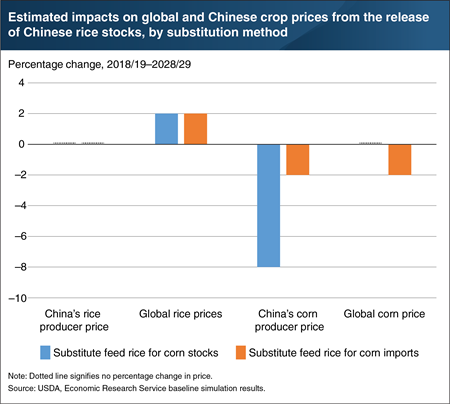
Wednesday, March 20, 2019
In China, rice stocks (unused rice kept in storage) are projected to reach a record 113 million tons at the end of the 2018/19 marketing year this June, the 12th consecutive year of increasing stocks. Currently, China is estimated to hold about 70 percent of the world’s stocks of rice. Chinese policymakers are considering releasing excess rice stocks for use as an alternative to corn in livestock feed. The ERS 10-year baseline model shows that the effect of releasing rice into feed markets would depend on whether rice is substituted for corn held in stocks or for imported corn. In China, corn prices would fall much more sharply if rice is substituted for corn stocks rather than corn imports, according to the model, which simulated releases of stocks over a decade. However, globally, corn prices are only changed if corn imports are the source of the substitute. The model also shows that global rice prices would rise 2 percent regardless of the substitution source. This chart appears in the March 2019 Amber Waves article “The release of China’s rice stocks could impact global feed markets.”
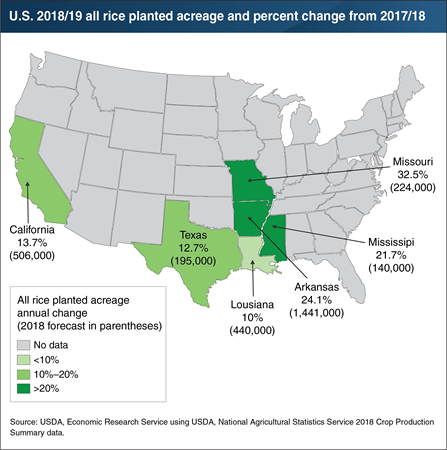
Monday, March 11, 2019
Almost all of the rice produced in the United States comes from six States: California, Texas, Missouri, Arkansas, Mississippi, and Louisiana. California is the major producer of short- and medium-grain varieties, while the remaining States mainly produce long-grain rice. The latest USDA data for the 2018/19 crop year show planted rice acreage increased in all of those States relative to the previous year, with Arkansas accounting for 58 percent of the 483,000-acre increase. Arkansas plantings for all types of rice were up 24 percent, to 1.4 million acres, with long grain accounting for the bulk of the increase. Farmers in Missouri and Mississippi increased long-grain rice acreage. Louisiana increased both long- and medium-grain acreage. Due to the drought in California from 2011 to 2017, planted acreage there has contracted since 2011. However, at 506 thousand acres, the California 2018/19 all-rice plantings broke the 500-thousand-acres barrier for just the second time since 2013. This chart appears in the ERS Rice Outlook: February 2019 newsletter.
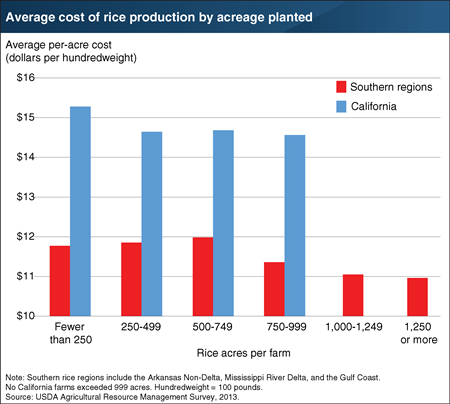
Wednesday, February 20, 2019
Economies of size exist in crop production if unit costs decline as per-farm crop acreage increases. The existence of economies of size is a driving force behind changes in operation size and farm productivity. Using data from 2013, rice costs per hundredweight (cwt) were summarized for size groups indicated by the number of rice acres per farm in California and in Southern U.S. rice-growing regions. In California, where rice production costs are higher than in the South, nearly all economies of size were achieved on farms with 250-499 rice acres. Farms with 250-499 acres had production costs that were 4.2 percent less than those of farms with fewer than 250 acres. However, average unit costs for rice production on California farms did not decline much more on larger farms. In the South, production costs per cwt were much the same for operations in size groups with less than 750 rice acres. However, economies of size were present for operation sizes greater than 750 rice acres. Higher cost savings on larger farms in the South suggest that the potential to further exploit economies of size is much greater than that among California farms. This chart appears in the ERS report U.S. Rice Production in the New Millennium: Changes in Structure, Practices, and Costs, released in December 2018.
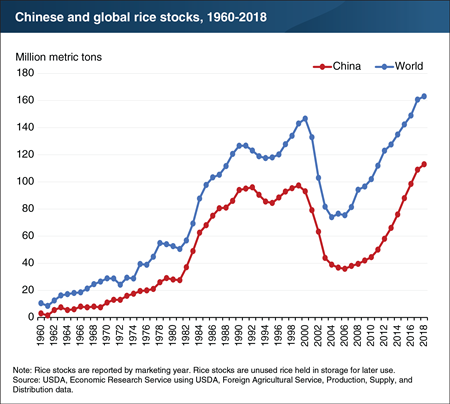
Wednesday, December 19, 2018
Rice stocks in China continue to climb, with 2018/19 marketing year ending stocks (unused rice kept in storage) projected at a record 113 million tons, or about 70 percent of the world’s stocks. By comparison, the United States is projected to hold 1.5 million tons of rice stocks. This is the 12th consecutive year of increasing stocks in China, the world’s largest rice producer and consumer. Rising commodity stocks typically indicate overproduction or reduced demand. Growing stocks can also reflect a variety of government policies. Governments may hold stocks as assurance against emergencies (such as food shortages and crop failures) or tight global supplies that could lead to global price spikes, or they may purchase large quantities of a commodity and hold it in storage to increase prices received by farmers. In general, government purchases insulate rice prices and provide price and demand stability. In line with China’s increased focus on agriculture and self-sufficiency, the Government raised rice support prices annually from 2008 to 2015, which resulted in overproduction. A version of this chart appears in the December 2018 ERS report, Rice in Asia’s Feed Markets.
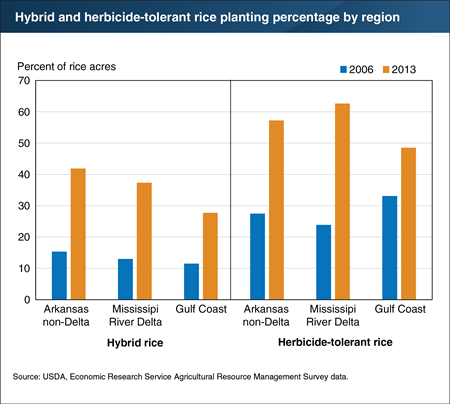
Monday, December 10, 2018
Data from USDA’s Agricultural Resource Management Survey of U.S. rice farms indicate that southern rice producers increased the planting of both hybrid and herbicide-tolerant seed between 2006 and 2013. Hybrid rice gained favor primarily because it is higher yielding than conventional rice. From 2006 to 2013, hybrid rice acreage increased in all major southern rice-producing regions. Herbicide-tolerant rice is bred to withstand applications of specific herbicides that kill targeted weeds, particularly “red rice” in the South. This feature allows producers to apply herbicides after both the rice and weeds have emerged, killing targeted weeds without harming the rice. Unlike other herbicide-tolerant crops, herbicide-tolerant rice varieties have been developed through traditional plant-breeding methods rather than genetic modification. From 2006 to 2013, herbicide-tolerant rice acreage increased from 27 to 57 percent of acres in the Arkansas Non-Delta, from 24 to 63 percent of acres in the Mississippi River Delta, and from 33 to 49 percent of acres in the Gulf Coast. These data appear in the ERS report, U.S. Rice Production in the New Millennium: Changes in Structure, Practices, and Costs.
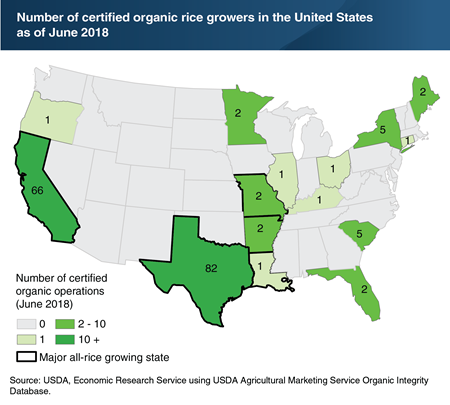
Thursday, August 16, 2018
In June, USDA’s Organic Integrity Database (OIDB) reported 173 certified organic rice growers in the United States, 86 percent of which operate in California and Texas. The OIDB is managed by the USDA, Agricultural Marketing Service National Organic Program and reports all USDA-certified organic operations in the United States and abroad. Arkansas, the largest conventional rice-producing State, has two certified organic growers. In 2016, the 109 certified organic rice producers in the United States accounted for 32,000 harvested acres, 140 million pounds produced, and nearly $43 million in farm sales of organic rice, according to the USDA, National Agricultural Statistics Service Certified Organic Survey. Compared to the previous year, 2016 U.S. organic rice acreage increased by 11 percent and production increased by 10 percent, although this still was less than 1 percent of the total 2016 U.S. rice production of over 2.2 billion pounds. This chart appears in a special article on the U.S. organic rice market in ERS’s July 2018 Rice Outlook newsletter.
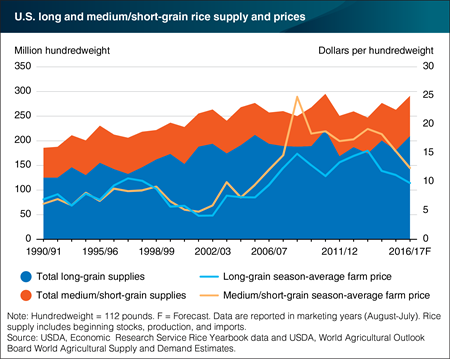
Wednesday, March 8, 2017
U.S. supplies of rice increased 58 percent since the 1990/91 marketing year. The majority of this growth occurred in the long-grain variety, where supplies grew 67 percent, compared with 35 percent gains in short/medium grain rice. Imports make up an increasing share of supply in recent years, but still remain below 9 percent of the total. Farm prices for both rice categories were relatively stable between 1990/91 and 2006/07, but a global rice crisis in 2008 led to a significant increase in prices, particularly of the medium/short variety, which reached an average of $25 per hundredweight in 2008/09. Prices declined following the crisis, but still remain elevated relative to historic levels. Supply is projected to total 294 million hundredweight in the 2016/17 marketing year. This would be the second highest total on record for the United States, trailing only 2010/11 when record production led to 297 million hundredweight in the U.S. market. Just under half of U.S. rice supply is exported with the remainder consumed or stored domestically. This chart is drawn from data discussed in the ERS Rice Outlook report released in February 2017.
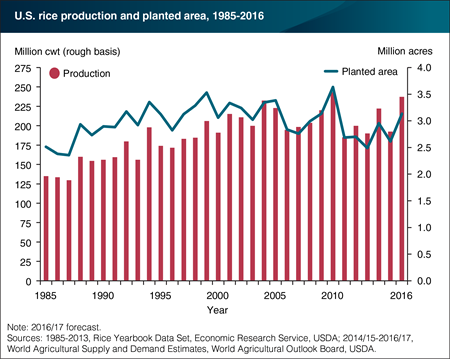
Thursday, September 29, 2016
The 2016/17 U.S. rice crop is projected to reach near record levels according to USDA forecasts. The projection of 237.1 million cwt (hundredweight or cwt is equal to 100 pounds) would be the second highest rice harvest on record—following only 2010’s production of 243.1 million cwt. The forecast projects a large growth in production compared to the 2015/16 harvest, when production totaled 192.3 million cwt. The growth is due in part to a 20 percent increase in planted area (to 3.1 million acres). Factors contributing to the increased planted area include the relaxation of water use restrictions in Texas and California, a lack of more profitable planting options, and a return to more normal weather in the Mississippi Delta region. The majority of U.S. rice is produced in five states: Arkansas, California, Louisiana, Mississippi, Missouri, and Texas. This chart is based on data found in ERS’s September 2016 Rice Outlook report.
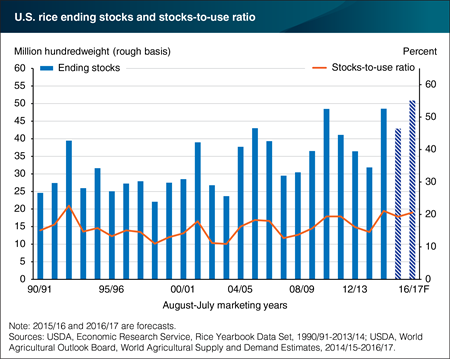
Friday, July 1, 2016
U.S. ending stocks of rice for the 2016/17 (August-July) marketing year are projected at 50.9 million hundredweight (cwt), up 19 percent from a year earlier and the highest since 1986/87. The substantial buildup in stocks is the result of a large increase in 2016/17 production that exceeds the gains expected in domestic use and exports. U.S. rice production for the 2016/17 marketing year is expected to reach 231.0 million cwt, the highest since 2010/11 and third largest on record. The bumper crop—up 20 percent from a year earlier—is primarily due to a large increase in harvested area as well as a slightly higher expected yield. At 3.06 million acres, 2016/17 plantings are up 17 percent from a year earlier and the highest since 2010/11. The substantial area increase is largely due to a return of several hundred thousand acres in the South that were not planted last year due to adverse weather, a lack of economically viable alternatives at planting time in the southern States, and an end to water restrictions in the Texas Rice Belt. The rising level of rice stocks in the United States is in contrast to the tightening stock levels currently faced by several of the world’s largest exporters—primarily India, Thailand, and Pakistan. Global ending stocks, excluding China, are expected to be down 13 percent from a year earlier, the fourth consecutive year of decline and the lowest since 2004/05. This chart is from the Rice Outlook June 2016 report.
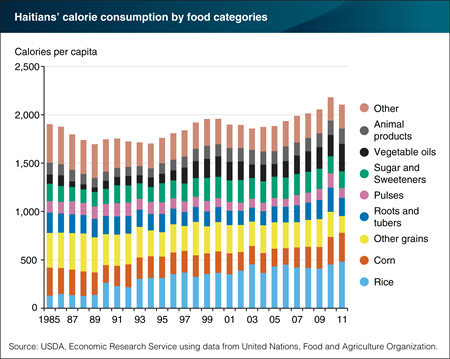
Friday, May 20, 2016
Haiti is one of the poorest nations in the world, and rice is a critical component of the Haitian diet. In 1985, the supply of rice per capita in Haiti was estimated at only 13.1 kilograms per year, well below the 31 kilograms for corn and 94 kilograms for starchy roots, historically the largest component of Haiti’s food supply. In 1986, Haiti began to open its market to imported rice, and by 2011 per-capita rice availability grew to 48 kilograms. Rice imports also changed the character of the Haitian diet, with rice now accounting for almost one-quarter of total calorie consumption. Since 1985, per-capita food availability of all foods, in calories, increased by about 11 percent, mirroring the increase in rice and resulting in improved food security. Efforts are underway in Haiti to increase its domestic agricultural output, but even with significant productivity gains, Haiti is likely to continue to rely on imported rice for a large part of its food needs. This chart is from the February 2016 report, Haiti’s U.S. Rice Imports.
_450px.png?v=8162.2)
Friday, April 1, 2016
U.S. rice production declined 13 percent in 2015/16 (August-July) to 192.3 million hundredweight (cwt), down 29.9 cwt from a year earlier. The decline in production was the result of both smaller plantings and a lower average yield. At 2.614 million acres, 2015/16 rice plantings were 11.5 percent below a year earlier, primarily reflecting weather-related problems that included excessive rain in the Mississippi Delta early in the growing season and long-term drought in California and Texas. The U.S. average yield of 7,470 pounds per acre was 1.4 percent below a year earlier, largely due to the adverse weather in much of the South that delayed plantings and interfered with field operations during the growing season. Despite the sharp decline in the 2015 crop, U.S. supplies are projected to contract by only 5 percent due to the substantial quantity of rice that was carried over from the previous year, when production reached the fourth highest level on record due to strong prices and normal weather in the South that boosted acreage. This chart is from the Rice Outlook, March 2016.
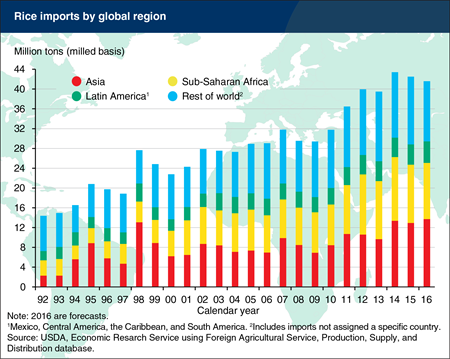
Wednesday, March 9, 2016
Global trade in rice is expected to decline for the second consecutive year in 2016, reflecting reduced exports from India, Australia, Cambodia, and the United States, and softening demand, particularly in Sub-Saharan Africa. Reduced imports by Nigeria—the world’s second-largest rice import market—account for the largest share of the decline in global rice trade. Imports by Nigeria are expected to fall 17 percent in 2016, the result of a recent increase in import tariffs, declining oil revenues, and foreign exchange restrictions. Cote d’Ivoire, Cuba, the European Union, Nepal, and Sri Lanka are also expected to reduce rice imports this year. The decline in global trade comes despite further growth in demand by China, the world’s largest rice importing country, as well as expanded imports by the Middle East and Indonesia. Rice imports by China have been at record high levels since 2012 and are expected to grow 4 percent in 2016, reflecting prices that are lower in the global market than the domestic market, stock-building efforts by the government, and quality concerns regarding domestic rice.


